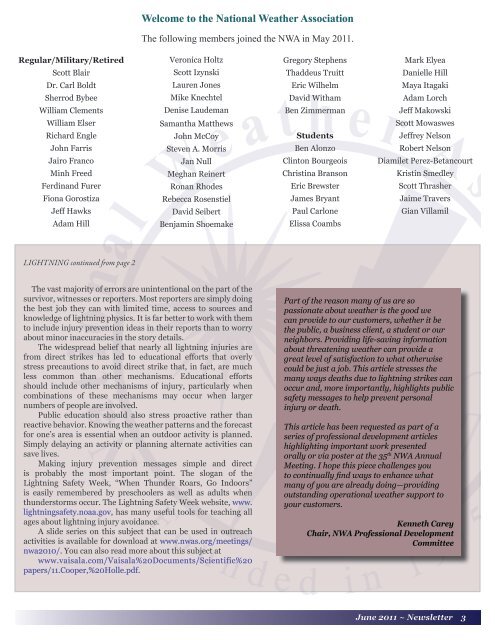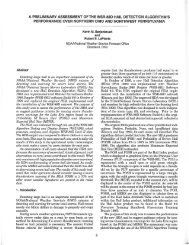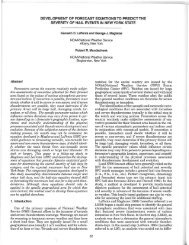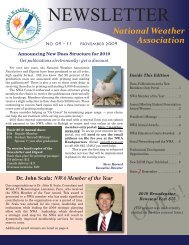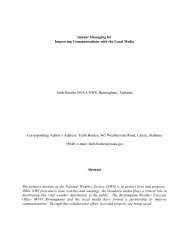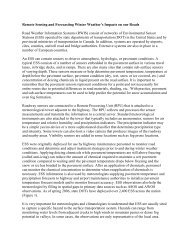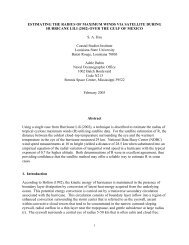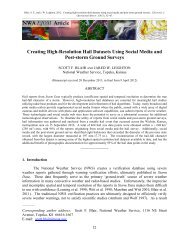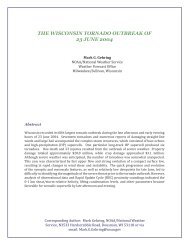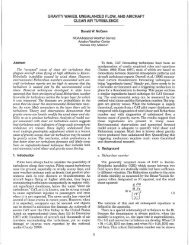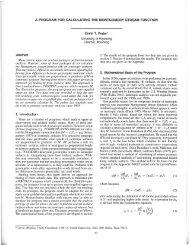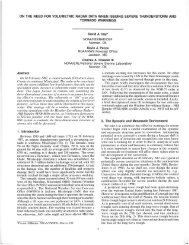NEWSLETTER - National Weather Association
NEWSLETTER - National Weather Association
NEWSLETTER - National Weather Association
Create successful ePaper yourself
Turn your PDF publications into a flip-book with our unique Google optimized e-Paper software.
Welcome to the <strong>National</strong> <strong>Weather</strong> <strong>Association</strong><br />
The following members joined the NWA in May 2011.<br />
Regular/Military/Retired<br />
Scott Blair<br />
Dr. Carl Boldt<br />
Sherrod Bybee<br />
William Clements<br />
William Elser<br />
Richard Engle<br />
John Farris<br />
Jairo Franco<br />
Minh Freed<br />
Ferdinand Furer<br />
Fiona Gorostiza<br />
Jeff Hawks<br />
Adam Hill<br />
Veronica Holtz<br />
Scott Izynski<br />
Lauren Jones<br />
Mike Knechtel<br />
Denise Laudeman<br />
Samantha Matthews<br />
John McCoy<br />
Steven A. Morris<br />
Jan Null<br />
Meghan Reinert<br />
Ronan Rhodes<br />
Rebecca Rosenstiel<br />
David Seibert<br />
Benjamin Shoemake<br />
Gregory Stephens<br />
Thaddeus Truitt<br />
Eric Wilhelm<br />
David Witham<br />
Ben Zimmerman<br />
Students<br />
Ben Alonzo<br />
Clinton Bourgeois<br />
Christina Branson<br />
Eric Brewster<br />
James Bryant<br />
Paul Carlone<br />
Elissa Coambs<br />
Mark Elyea<br />
Danielle Hill<br />
Maya Itagaki<br />
Adam Lorch<br />
Jeff Makowski<br />
Scott Mowaswes<br />
Jeffrey Nelson<br />
Robert Nelson<br />
Diamilet Perez-Betancourt<br />
Kristin Smedley<br />
Scott Thrasher<br />
Jaime Travers<br />
Gian Villamil<br />
LIGHTNING continued from page 2<br />
The vast majority of errors are unintentional on the part of the<br />
survivor, witnesses or reporters. Most reporters are simply doing<br />
the best job they can with limited time, access to sources and<br />
knowledge of lightning physics. It is far better to work with them<br />
to include injury prevention ideas in their reports than to worry<br />
about minor inaccuracies in the story details.<br />
The widespread belief that nearly all lightning injuries are<br />
from direct strikes has led to educational efforts that overly<br />
stress precautions to avoid direct strike that, in fact, are much<br />
less common than other mechanisms. Educational efforts<br />
should include other mechanisms of injury, particularly when<br />
combinations of these mechanisms may occur when larger<br />
numbers of people are involved.<br />
Public education should also stress proactive rather than<br />
reactive behavior. Knowing the weather patterns and the forecast<br />
for one’s area is essential when an outdoor activity is planned.<br />
Simply delaying an activity or planning alternate activities can<br />
save lives.<br />
Making injury prevention messages simple and direct<br />
is probably the most important point. The slogan of the<br />
Lightning Safety Week, “When Thunder Roars, Go Indoors”<br />
is easily remembered by preschoolers as well as adults when<br />
thunderstorms occur. The Lightning Safety Week website, www.<br />
lightningsafety.noaa.gov, has many useful tools for teaching all<br />
ages about lightning injury avoidance.<br />
A slide series on this subject that can be used in outreach<br />
activities is available for download at www.nwas.org/meetings/<br />
nwa2010/. You can also read more about this subject at<br />
www.vaisala.com/Vaisala%20Documents/Scientific%20<br />
papers/11.Cooper,%20Holle.pdf.<br />
Part of the reason many of us are so<br />
passionate about weather is the good we<br />
can provide to our customers, whether it be<br />
the public, a business client, a student or our<br />
neighbors. Providing life-saving information<br />
about threatening weather can provide a<br />
great level of satisfaction to what otherwise<br />
could be just a job. This article stresses the<br />
many ways deaths due to lightning strikes can<br />
occur and, more importantly, highlights public<br />
safety messages to help prevent personal<br />
injury or death.<br />
This article has been requested as part of a<br />
series of professional development articles<br />
highlighting important work presented<br />
orally or via poster at the 35 th NWA Annual<br />
Meeting. I hope this piece challenges you<br />
to continually find ways to enhance what<br />
many of you are already doing—providing<br />
outstanding operational weather support to<br />
your customers.<br />
Kenneth Carey<br />
Chair, NWA Professional Development<br />
Committee<br />
June 2011 ~ Newsletter 3


